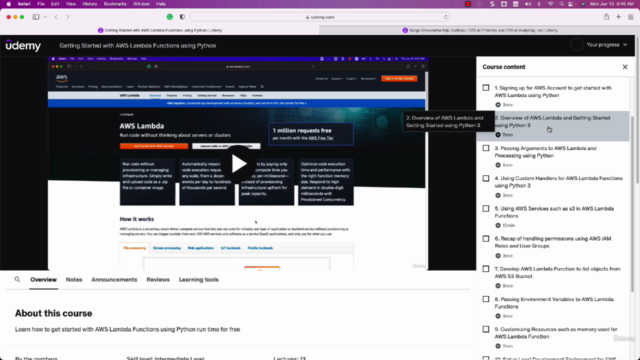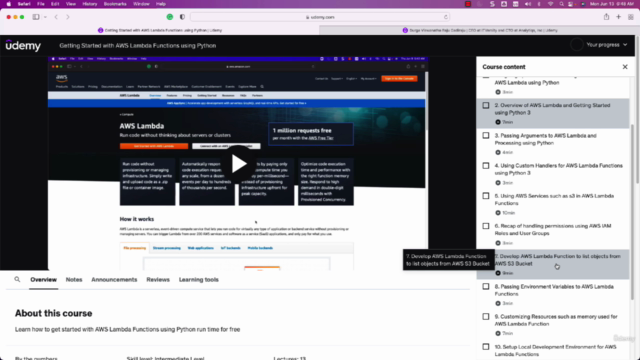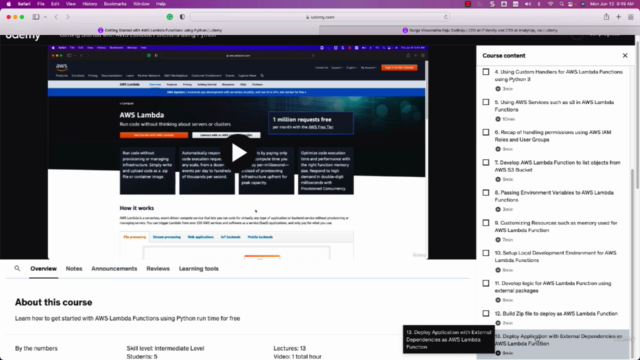Getting Started with AWS Lambda Functions using Python

Why take this course?
🚀 Getting Started with AWS Lambda Functions using Python 🐍
Course Overview:
Dive into the world of serverless computing and learn how to harness the power of AWS Lambda with Python as your runtime environment. This free course will guide you through the essentials of AWS Lambda, from setting up your first function to integrating it with other AWS services like S3, managing permissions, and deploying applications with external dependencies.
Course Highlights:
-
AWS Lambda Overview: Get started with the core concepts of AWS Lambda and understand its place in the modern IT landscape.
-
Python 3 Compatibility: Learn how to use Python 3 as the runtime for your AWS Lambda functions.
-
Passing Arguments: Discover how to pass arguments to your AWS Lambda functions and handle them effectively.
-
Custom Handlers: Master the art of defining custom handlers in your Python modules for better application organization.
-
Interacting with AWS Services: Understand how to use AWS services, such as S3, within your Lambda functions.
-
IAM Roles and Permissions: Recap the important role of AWS IAM roles and user groups in managing permissions for secure operations.
-
Developing Applications: Develop applications that can be deployed as AWS Lambda functions, complete with local development environment setup.
-
Deployment and Zip Files: Learn to build a zip file containing your AWS Lambda function code and dependencies, ready for deployment.
Detailed Course Outline:
-
Prerequisites: Ensure you have a valid AWS account, which is necessary for deploying AWS Lambda functions.
-
First Steps with AWS Lambda: Deploy your first application using Python 3 run-time via the AWS Web Console.
-
Passing Arguments to Applications: Understand how to pass arguments to your AWS Lambda function at runtime and process them within your application.
-
Custom Handlers Configuration: Learn how to configure custom handlers for your AWS Lambda functions, which is crucial when managing multiple functions in a single codebase.
-
AWS Services Integration: Interact with AWS services like S3 as part of your Lambda function's logic.
-
IAM Roles and Permissions: Gain insights into how permissions are handled between different AWS services using IAM roles.
-
Lambda Function Enhancements: Update your application to list objects in an S3 bucket, enhancing the functionality of your Lambda function.
-
Environment Variables: Utilize environment variables to pass configuration data and customize the behavior of your AWS Lambda functions without changing the code.
-
Resource Management: Review and customize resources like memory, CPU, ephemeral storage, and timeout for your Lambda function to ensure optimal performance.
-
Local Development Environment Setup: Explore how to set up a local environment for Python-based AWS Lambda function development.
-
Developing with External Libraries: Develop new Lambda functions using third-party libraries, such as
requests, and build a zip file for deployment.
By the End of This Course:
You'll have a solid understanding of how to get started with AWS Lambda Functions using Python. You'll be equipped to deploy applications on AWS Lambda, manage resources, handle permissions, and integrate with other services – all for free! If you're looking to expand your skills further and work on more complex applications, our other courses on Udemy are here to continue your learning journey.
🎓 Embark on your serverless adventure today and unlock the potential of AWS Lambda with Python! 👨💻🐍✨
Course Gallery




Loading charts...